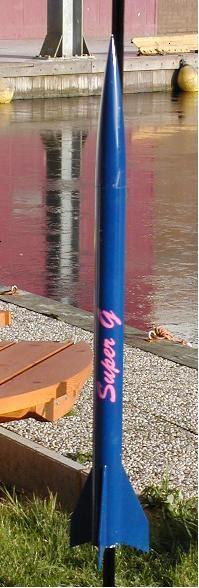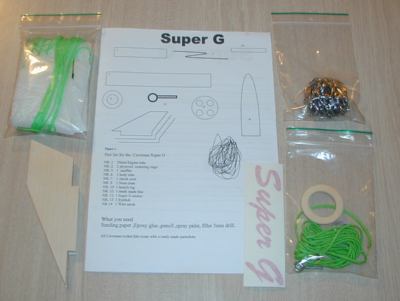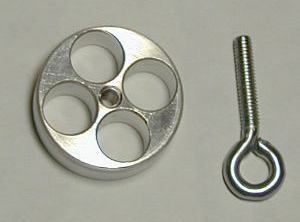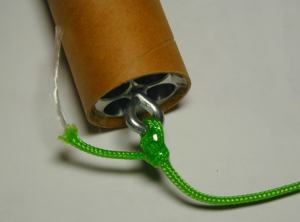| Published: | 2010-11-13 |
| Manufacturer: | Caveman Rocketry  |
![[Picture]](/images/archive/images/ratings/rating_cm_superg.gif) (05/10/03) Caveman Rocketry asked me to
beta-test a new idea they had called CCD (Cut Cost Down). The thought is that
instead of shipping the whole rocket kit from the Netherlands to U.S., they would
only ship the unique parts and the modeler would purchase the remainder parts
from local sources. It would be cheaper, because Caveman uses parts that come
of the U.S. and have to pass on the shipping costs to get them to the Netherlands
and then have to turn-around and charge you shipping charges again to get them
back to you. For modelers it can be a bitter-sweet experience. Bitter
because we have to buy parts from someone here locally to make up a
"kit". Sweet because we can save money - OR - use parts we may
already have. That is what I did.
(05/10/03) Caveman Rocketry asked me to
beta-test a new idea they had called CCD (Cut Cost Down). The thought is that
instead of shipping the whole rocket kit from the Netherlands to U.S., they would
only ship the unique parts and the modeler would purchase the remainder parts
from local sources. It would be cheaper, because Caveman uses parts that come
of the U.S. and have to pass on the shipping costs to get them to the Netherlands
and then have to turn-around and charge you shipping charges again to get them
back to you. For modelers it can be a bitter-sweet experience. Bitter
because we have to buy parts from someone here locally to make up a
"kit". Sweet because we can save money - OR - use parts we may
already have. That is what I did.
Picture Courtesy of
Caveman Rocketry

The SuperG is according to Caveman Rocketry, "This rocket is made of a simple but durable construction, the simple construction makes it a high performing rocket that can be flown on any type of 29 mm rocket engine, the captain advises you not to use rocket engines higher than a G, unless you don't mind to land yours on the moon this rocket will exceed 4000 feet on a G80 engine.". As designed it should weigh in at about 5.3 ounces, so you could fly this SuperG on as small of a motor as a D12-3.
The CCD kit came with:
- (2) laser-cut plywood centering rings
- (3) plywood fins
- (1) Aluminum Muffler with Eyebolt
- (1) Wire Mesh
- (1) Neon Green Shockcord (special cord used to make power kites)
- (1) 24" Caveman Ready-made Rip-stop Nylon Parachute
- (1) SuperG sticker
Caveman indicates that you need to provide the following Aerotech parts:
- Body Tube - 1.9 in Slot / 3-Fin 22.75 in p/n -48365-
- Nose Cone - 1.9 in 5/1 Ogive p/n -48381-
- Motor Mount 29mm x 12 inch Motor Mount Tube p/n -50338-
CONSTRUCTION:
 The instructions provided with the beta-test kit are
the same ones provided with the full SuperG kit. I provided feedback on how
these should be adjusted for the CCD kit. The instructions are brief and have a
few illustrations. Overall, they can get the builder through if it is an
experienced builder, otherwise, they need to be spruced up and improved in
format.
The instructions provided with the beta-test kit are
the same ones provided with the full SuperG kit. I provided feedback on how
these should be adjusted for the CCD kit. The instructions are brief and have a
few illustrations. Overall, they can get the builder through if it is an
experienced builder, otherwise, they need to be spruced up and improved in
format.
The SuperG is a very straight forward rocket to build. I'm only going to highlight a couple of unique areas in the build.
To get started, I didn't go buy the exact Aerotech parts listed. I already had the Aerotech nose cone. I also had the Aerotech non-slotted version of the body tube, so I slotted my own. I use a hobby knife and several passes when slotting tubes. It works. Lastly, I had a 12" motor tube, but mine was phenolic so I had to sand the centering rings (a lot) to get them to fit around the motor tube. This also added a bit of weight to my rocket.
A unique feature of the SuperG is Caveman's "Muffler". It is a aluminum disk with 4 exhaust ports cut into it and an eye-screw is screwed into the center. This is glued into the top of the motor tube. The eye-screw is screw in and then the shockcord is attached to the eye-screw. This is a very "beefy" system. To complete the "Muffler", a wire mesh is inserted into the bottom of the motor mount so that it is above the motor and below the "Muffler". This makes the rocket "wadless".


The fins are through-the-wall as you have probably already gathered. I had to sand them a lot to accommodate the phenolic tube I used. This is not Caveman's problem since I strayed from the recommended motor tube.
Caveman's instructions tell you where your Center of Gravity should be. I had to add about 1.2 ounces of clay to the nose cone to get mine to balance correctly. I'm sure this amount was needed due to the phenolic motor tube and the epoxy fillets. My overall, unfinished, weight was 8.67 ounces.
And that, folks, is pretty much it!
I didn't even finish my rocket as I wanted to get out there and fly it as soon as possible. The kit did come with a SuperG sticker (as seen in the picture above).
Overall, for CONSTRUCTION I would rate this kit 3 ½ points. The quality of the components, especially the "Muffler" is outstanding. The instructions need a bit of work to make the kit complete and there needs to be attention to the illustrations. Remember though this was a beta-kit for the CCD program (although these were the released instructions for the SuperG kit). The kit does not come with motor retention.
FLIGHT/RECOVERY:
Even at my finished weight, it RockSim'd fine on a D12-3. I choose to use a 24mm adaptor and try it on some new Estes' E9-4's. The 4 second delay sim'd short and a 5 second delay would be better, but Estes sells E9-4's!

I decided not to use the parachute and install a B2 3" streamer. I friction fit the 24mm adaptor and friction fit the E9-4 into the motor mount. No wadding is needed with the "Muffler" system.
First flight was straight as an arrow. The E9 is a very nice match for this rocket. Even the 4 second delay was okay. The E9 has a chug-chug high-tech sound to it. I really like it. The B2 Streamer came out and recovery was excellent.
Let's do it again!
When I pulled out the spent E9 small chunks of clay came out that had been trapped by the wire mesh. I shook the rocket and tapped it a bit to get the remainder out, then loaded a second E9-4.
Another nice and straight flight. This time the ejection only popped the nose cone and the streamer stayed stuck in the body tube. I watched it fall into a young (but tall) tree. She still sits there today after numerous attempts to get her with my rope and hook. Oh, by the way, my rope and hook are stuck in the tree now too because the hook got wedged in the tree joint!
The rocket is a nice size for those D12 and E9 flights, but will be out-of-sight on 29mm motors. It will "exceed 4000 feet on a G80 engine". Mine sims a bit less due to the added weight.
The wadless system is nice and the wire mesh is easy to get out (not built into any tube). Just reach up into the motor tube with a hook and pull it out. Easy to clean.
For FLIGHT/RECOVERY, I would rate this kit 5 points. Although I only have two flights and it is now stuck in a tree, the straight flight, versatility of motor selection, wadless "Muffler" system, and easy to remove/clean wire mesh make this a very nice rocket. According to Caveman, "... we have had several drag races with the original kit and we swept the floor with all the Aerotech kits we raced. The only time we lost the race we blew out the igniter and the engine took 3 second to come to pressure."
SUMMARY:
I give the kit an OVERALL rating of 4 points. It was a beta-kit, so there are some obvious areas that need to be corrected for production. I have pointed these out to a very receptive Caveman Rocketry. The rocket's size and versatility should make it attractive to those that are interested in getting in mid-power rocketry.
The idea of CCD is unique and may have a market. Best wishes to Caveman on this. I feel to make the CCD kits MORE attractive, the fins need to be unique shapes and the parachute has to be an option. The reason I feel this way is because the SuperG fins would not take me too much to make, but something with more complicated cuts and such would.
In addition, for a CCD kit, the instructions may need to be enhanced to address some common variations. For example they might say, "You may choose to use an unslotted, 1.9" tube. If you do you need to do this......." or "You may choose to use a non-Aerotech 29mm tube. If you do you need to do this......".
 |
 |
Flights
 |
 |